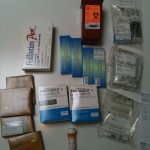Note to the Reader: We are honored to feature three of Huffington Post writer MeiMei Fox’s five posts regarding her recent experiences with egg freezing, commonly called “oocyte cryopreservation.” MeiMei shares her personal experiences in an effort to spread awareness of this fertility option to other women her age. Please do not consider it a substitute for advice from a medical professional.
The Box
This morning, a FedEx box arrived containing $3,300 worth of medications. And so begins the process of freezing my eggs.
“It’s a miracle!” says my best friend Jen, the mother of two. And I agree.
Yet I can’t help but feel sad as I open the box and sort through the piles of hormones, syringes, needles, and gauze pads, placing a few precious bottles of follicle stimulating hormone (FSH) in the fridge. This is not what I wanted to be doing at age 37½, alone. I wanted to be having a child years ago, with my (now ex) husband. Confronted with such undeniable evidence of my status as a single and childless woman who is running out of time, tears flood out, unbidden and uncontrollable.
I’m grieving… the loss of a romantic dream, the passing of my youth, and something else more elusive: the illusion that if I worked hard, was a kind-hearted and sincere person, served the planet, and safeguarded my own physical and psychological wellbeing, then I would get what I wanted and deserved.
One year ago, I sat with Dr. Jamie Grifo, one of the top fertility doctors in America, at his New York University office in Manhattan, as he presented charts revealing how much more difficult it would become, with each passing month (not year), for me to get pregnant and bear a healthy child due to my age. Oocyte cryopreservation technology has only just been established as a viable option. Even two years ago, most doctors encouraged their clients to freeze embryos, not eggs. But this would require me to choose the sperm donor now, which is precisely not what I’m ready to do.
Now that doctors have figured out how to freeze and unfreeze fragile eggs with nearly as much success as they freeze embryos (approximately 50 percent of eggs survive the process), I can take charge of my fertility. With a few tests, two weeks worth of pricey hormone injections, several ultrasounds, and a simple non-surgical procedure, I can attempt to have my 37½ year-old eggs available to me for the rest of my life. This way, when I meet a partner and we choose to get pregnant, I can use the eggs if we have difficulty or if I’m over 40. Or, should I choose to have a child alone, I can select the sperm at that time and have a greater chance of success with my younger eggs.
Egg freezing, from my point of view, really is a miracle. At a cost of approximately $11,000 at the Stanford Fertility and Reproductive Medicine Center where I’ve chosen to have the procedure done, it is a financial sacrifice that I am willing to make (insurance doesn’t yet cover any of it).
I may not be able to control when, or if, I meet the man who is ready to settle down with me, have children, and be my life partner. But I do have control, for a few years longer at least, of my fertility. By taking action, I hang on to the hope that some day, I will find my desire for biological children of my own fulfilled.

